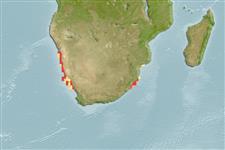>
Eupercaria/misc (Various families in series Eupercaria) >
Sparidae (Porgies)
Etymology: Lithognathus: Greek, lithos = stone + Greek, gnathos = jaw (Ref. 45335).
More on author: Cuvier.
Environment: milieu / climate zone / intervalo de profundidade / distribution range
Ecologia
marinhas; estuarina bentopelágico; anfídromo (Ref. 51243); intervalo de profundidade ? - 150 m (Ref. 27121). Subtropical; 22°S - 31°S
Southeast Atlantic: known only from the Orange River mouth to Natal, South Africa.
Length at first maturity / Tamanho / Peso / Idade
Maturidade: Lm 54.0 range ? - ? cm
Max length : 200 cm TL macho/indeterminado; (Ref. 3198); common length : 65.0 cm TL macho/indeterminado; (Ref. 3507)
Descrição breve
Chaves de identificação | Morfologia | Morfometria
Espinhos dorsais (total) : 11; Raios dorsais moles (total) : 10; Espinhos anais: 3; Raios anais moles: 8. Silvery in color, crossbars fade with age.
Body shape (shape guide): fusiform / normal.
Found over sandy substrate, in estuaries and oceanic waters. Enters lagoons (Ref. 3198). Feeds bottom invertebrates, including worms, crabs and shrimp (Ref. 27121). Spawns in the sea but uses estuaries as nursery grounds. Prime angling fish. Important food fish. Sold fresh and whole in markets.
Life cycle and mating behavior
Maturidade | Reprodução | Desova | Ovos | Fecundidade | Larvas
Bauchot, M.-L. and M.M. Smith, 1984. Sparidae. In W. Fischer and G. Bianchi (eds.) FAO species identification sheets for fishery purposes. Western Indian Ocean (Fishing Area 51). volume 4. [var. pag.] FAO, Rome. (Ref. 3507)
Categoria na Lista Vermelha da IUCN (Ref. 130435: Version 2025-1)
Ameaçada (EN) (A2bcd; B2ab(ii,v)); Date assessed: 04 December 2009
Ameaça para o homem
Harmless
Utilização humana
Pescarias: pouco comercial; peixe desportivo: sim
Ferramentas
Relatórios especiais
Descarregue XML
Fontes da internet
Estimates based on models
Preferred temperature (Ref.
123201): 12.5 - 24.1, mean 15.7 °C (based on 28 cells).
Phylogenetic diversity index (Ref.
82804): PD
50 = 0.5625 [Uniqueness, from 0.5 = low to 2.0 = high].
Bayesian length-weight: a=0.01549 (0.00939 - 0.02556), b=3.04 (2.90 - 3.18), in cm total length, based on LWR estimates for this species & (Sub)family-body (Ref.
93245).
Nível Trófico (Ref.
69278): 3.1 ±0.1 se; based on diet studies.
Generation time: 10.9 ( na - na) years. Estimated as median ln(3)/K based on 1
growth studies.
Resiliência (Ref.
120179): Baixo, tempo mínimo de duplicação da população 4,5 - 14 anos (K=0.1).
Fishing Vulnerability (Ref.
59153): High to very high vulnerability (72 of 100).
🛈
Climate Vulnerability (Ref.
125649): Very high vulnerability (78 of 100).
🛈
Nutrients (Ref.
124155): Calcium = 24.8 [12.9, 45.8] mg/100g; Iron = 0.664 [0.364, 1.136] mg/100g; Protein = 18.5 [16.9, 20.3] %; Omega3 = 0.302 [0.191, 0.497] g/100g; Selenium = 45.7 [21.7, 85.5] μg/100g; VitaminA = 6.95 [2.03, 19.38] μg/100g; Zinc = 0.722 [0.505, 1.031] mg/100g (wet weight);
